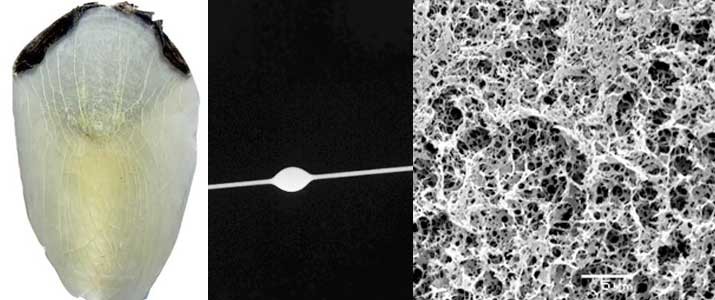Our research interests have varied over time. In general we can say that our work seeks to reveal important relationships in structure – properties in materials of biological or synthetic origin, polymeric structure with at least one of its components.
- BIONANOCOMPOSITES: The bionanocomposites can be considered a subgroup nanocomposites polymer where nanoreinforcements or the matrix come from renewable sources. We seek to develop new materials based on bionanocomposites capable of replacing conventional plastics made from hydrocarbons of many applications ranging from short-lived packaging to biomedical applications, promoting the sustainable economical development and making them environmentally attractive technologies. In POLYCOM we developed nanocomposites starch, chitosan, including bacterial cellulose polymers ( Grande, Torres et al, 2008 ; Grande, Torres et al, 2009)
- Fernando G. Torres, Solene Commeaux, Omar P. Troncoso, Starch-based biomaterials for wound-dressing applications, Starch – Stärke, Volume 65, Issue 7-8, pages 543–551, (2013)
- Torres, F. G.; Troncoso, O. P. y Montes, M, Effect of temperature on the mechanical properties of a protein-based biopolymer network, The Journal of Thermal Analysis and Calorimetry, 111 (3), pp. 1921-1925, (2013)
- F. G. Torres; O. P. Troncoso; C. Torres; D. A. Díaz; E. Amaya, Biodegradability and mechanical properties of starch films from Andean crops, International Journal of Biological Macromolecules, 48: 603-606, (2011).
- BIODEGRADABLE POLYMERS: Biodegradable polymers are materials that degrade in the presence of a biological agent , which makes them environmentally safe. For a material to be considered biodegradable , quantifiable tests must be done to ensure that the microorganisms can break down the materials through enzymatic action , producing carbon dioxide , water and biomass . We have developed various bioplastics , especially from native starches.
- Fernando G. Torres, Solene Commeaux, Omar P. Troncoso, Starch-based biomaterials for wound-dressing applications, Starch – Stärke, Volume 65, Issue 7-8, pages 543–551, (2013)
- Torres, F. G.; Troncoso, O. P. y Montes, M, Effect of temperature on the mechanical properties of a protein-based biopolymer network, The Journal of Thermal Analysis and Calorimetry, 111 (3), pp. 1921-1925, (2013)
- F. G. Torres; O. P. Troncoso; C. Torres; D. A. Díaz; E. Amaya, Biodegradability and mechanical properties of starch films from Andean crops, International Journal of Biological Macromolecules, 48: 603-606, (2011).
- BIOMEDICAL APPLICATIONS: In our laboratory we have developed porous structures for tissue engineering applications from biopolymers and bionanocomposites .
- F. G. Torres; O. P. Troncoso; C. Grande; D. A. Díaz, Biocompatibilty of starch-based films from starch of Andean Crops for biomedical applications, Materials Science and Engineering C 31 (8): 1737-1740, (2011).
- C.J. Grande, F.G. Torres, C. M. Gomez , M.C, Banó Nanocomposites of bacterial cellulose/hydroxyapatitefor biomedical applications, Acta Biomaterialia 5:1605–1615, (2009).
- F.G. Torres, A. Boccaccini, O.P. Troncoso, Microwave Processing of Starch-based Porous Structures for Tissue Engineering Scaffolds, Journal of Applied Polymer Science 103 (2): 1332-39, (2007).
- MATERIALS BIOLOGICAL ORIGIN: We study hard (fish scales, seeds, fish exoskeleton) and soft (bacterial cellulose gels, giant squid mantle) biological materials origin, besides the spider silk fibers and byssus of mollusk. We seek to reveal relationships structure – property through an approach that combines the mechanical, thermal, morphological characterization and numerical simulation.
- F. G. Torres, E. Le Bourhis, O. P. Troncoso, J. Llamoza, Structure-Property Relationships in Arapaima Gigas Scales Revealed by Nanoindentation Tests, Polymers and polymer composites, 2014
- F. G. Torres, O. P. Troncoso, E. R. Rivas, C. G. Gomez, D. Lopez, Reversible stress softening of collagen based networks from the jumbo squid mantle (Dosidicus gigas), Materials Science and Engineering: C, 37, (1), 9–13, (2014)
- F.G. Torres, O. P. Troncoso, C. Torres y W. Cabrejos , An experimental confirmation of thermal transitions in native and regenerated spider silks, Materials Science and Engineering: C, 33 (3), pp. 1432-1437. (2013).


